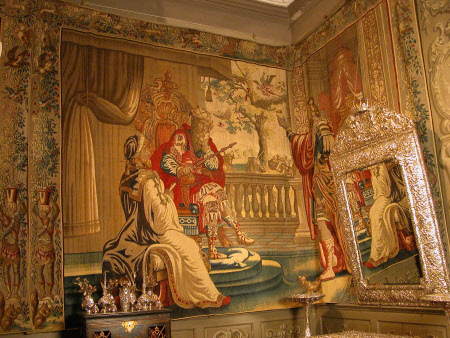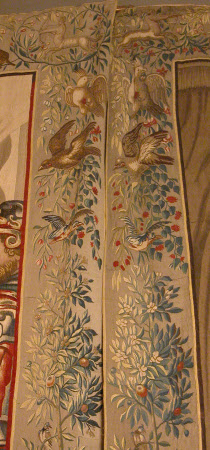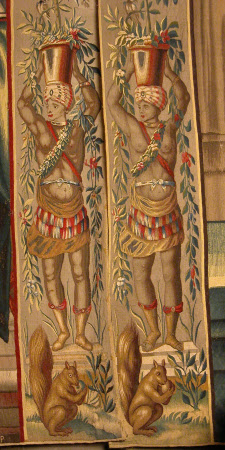Nebuchadnezzar’s Dream
Thomas Poyntz (fl. London c.1660, d. after 1688)
Category
Tapestries
Date
circa 1678 - circa 1682
Materials
Tapestry, wool and silk, 7 ½ warps per cm
Measurements
294 x 463 cm; 293 cm (Height); 464 cm (Width)
Place of origin
London
Order this imageCollection
Knole, Kent
NT 130090.2
Summary
Tapestry, wool and silk, 7 ½ warps per cm, Nebuchadnezzar’s Dream from a set of the Story of Nebuchadnezzar, Thomas Poyntz, London, c. 1678-1682. King Nebuchadnezzar sits on an elaborate golden throne on a raised dais on the left hand side of the tapestry, resting his head pensively on his hand and holding a golden sceptre. He wears a red cloak over a rich blue and gold tunic, a jewelled turban and a golden crown. There are curtains behind the throne, and beside the king sits an old man wearing golden robes and a blue turban, possibly one of the Chaldean priests. To the right Daniel approaches, gesturing with his hands as he explains the meaning of the King’s dream, while small dog crouches at his feet barking up at the King, and an armillary sphere rests on the ground next to him. The dream itself is represented in the centre, where there is a view across a balustrade to a landscape with a large tree inhabited by numerous species of birds and surrounded by animals including an elephant, a unicorn, a stag and a cow, and an angel flying down from the sky. On the far right is a view through to a background room where the King lies asleep in bed, dreaming. The side borders are composed of figure in ‘Indian’ dress, squirrels and plants on a light brown ground. In the upper border there are hunting scenes. The tapestry was woven without a lower border.
Full description
This is the second tapestry in the narrative sequence. The young Daniel first came to the notice of King Nebuchadnezzar by interpreting his dream when the wise men, the Chaldeans, could not. Nebuchadnezzar was so impressed with Daniel that he made him Governor of all Babylon, and chief of all the wise men (Daniel 2.1-25). Daniel later interpreted a second dream, and this is the subject of the tapestry (Daniel 4.1-27). Nebuchadnezzar related that he dreamed of a great tree, “And the leaves thereof were fair, and the fruit thereof much, and in it was meat for all: the beasts of the field had shadow under it, and the fowls of the heaven dwelt in the boughs thereof, and all flesh was fed on it” (Daniel 4.12). A ‘holy one’ then came down from heaven and commanded Nebuchadnezzar to cut down the tree but to leave the stump in the earth; and then said “Let it be wet with the dew of heaven, and let his portion be with the beasts in the grass of the earth; Let his heart be changed from man’s, and let a beast’s heart be given unto him; and let seven times pass over him.” (Daniel 4.15-6). When Nebuchadnezzar asked Daniel to interpret this dream, Daniel was troubled and would not speak; eventually he was persuaded to tell the King his interpretation, that he would be driven out and made to live like a beast unless he mended his sinful ways. Daniel’s prophecy came true, and this is the subject of the last tapestry in the sequence. The general arrangement of the scene, with the throne set in a marbled interior with a view across a balcony to a landscape with the tree of Nebuchadnezzar’s dream, is reminiscent of a print of the same subject by Adriaen Collaert after Jan van der Straet published in c. 1595 as part of a series of the ‘Seven Gifts of the Holy Spirit’. The dwarf in this print may have served as an inspiration for a dwarf in another tapestry in the ‘Nebuchadnezzar’ series, ‘The Golden Idol’. The five tapestries show scenes from the story of Daniel and Nebuchadnezzar, told in the Book of Daniel, chapters 1-5. Nebuchadnezzar, the King of Babylon, besieged Jerusalem and defeated Jehoiakim, the King of Judah, and his triumphant return is the subject of the first tapestry in the series, 130090.4. Nebuchadnezzar decided to take the brightest and most cunning of the children of Judah to be brought up in his palace, so that they might be taught the tongue of the high priests, the Chaldeans. Among the children taken were Daniel and his brothers Hananiah, Mishael, and Azariah. Daniel first came to the attention of King Nebuchadnezzar as a young man, when the king’s prophets had been unable to guess the meaning of his dreams. Daniel not only described the dreams, he was able to interpret their meaning; Nebuchadnezzar was awed by Daniel’s prophecy, and rewarded him richly. Later Daniel interpreted a second dream, foretelling that Nebuchadnezzar would be made to live with the beasts of the field if he did not mend his ways; this dream is the subject of the second tapestry in the series (130090.2). The third tapestry shows the Golden Idol which Nebuchadnezzar set up, ordering everyone to pay homage to it; this scene also includes in the background Nebuchadnezzar’s brutal punishment of Daniel’s brothers for refusing to worship the idol, and their miraculous escape from the fiery furnace (130090.3). The fourth tapestry shows Nebuchadnezzar’s brothers about to be thrown into the furnace (130090.4). The final tapestry represents the fulfilment of Daniel’s prophecy, and shows Nebuchadnezzar being struck down by the word of God, avian claws and feathers growing from his hands and arms (130090.1). The borders of the tapestries are decorated with leaves and plants on a light brown ground. At each side are figures in ‘Indian’ dress – bare-chested and wearing a turban, a skirt with coloured fringes and garlands of flowers – carrying pots with fruit trees on their heads. Below these there are red squirrels eating nuts, and above birds fly among branches. Along the upper borders there are hunting scenes with among the leaves and branches, with small figures bows and arrows, dogs, birds, deer, rabbits, goats and foxes. The tapestries are woven without lower borders but have a brown galloon along the lower edge. The designer of the ‘Nebuchadnezzar’ series is not known. Wendy Hefford has noted similarities with a series of the ‘History of Jephtha’ woven in Antwerp in the late seventeenth century, suggesting that the designer may have been Flemish, although there is no direct evidence for this (Hefford 2002, p. 60). ‘Nebuchadnezzar’s Dream’, the first tapestry in the series, shows some similarities to a print by Adriaen Collaert representing the same scene. The dwarf in Collaert’s print is also very similar to the dwarf who appears in the tapestry ‘The Golden Idol’; moreover no dwarf appears in the biblical account. This tapestry includes another intriguing reference, in the form of a small boy bedecked in flowers being led to worship the Golden idol. The pose and attributes of this boy are closely related to a child in a tapestry of ‘Niobe’s Pride’ from a series of the ‘Story of Diana’ designed by Karel van Mander and woven by François Spiering in Delft between c. 1590 and 1610. Van Mander’s tapestry designs are not known to have been engraved, but a version of ‘Niobe’s Pride’ is today at Knole and may have been in the Royal collection in the seventeenth century. Three of the tapestries at Knole are signed in the lower galloon with the initials T P either side of a white shield with a red cross of Saint George. The shield mark was first used at the Mortlake workshop from 1619 but by the later seventeenth century was a more general sign of English manufacture. The initials ‘T P’ are almost certainly those of Thomas Poyntz (d. 1685), an associate and probably a relative of Francis Poyntz, Yeoman Arrasworker to Charles II from 1661 until his death in 1684. Thomas Poyntz seems to have worked with Francis Poyntz in the 1670s and 1680s, and is first recorded in 1678 when the two men jointly signed a petition asking for concessions for immigrant catholic tapestry weavers in England (Thomson 1973, pp. 357-8). Thomas does not appear in Francis Poyntz’s will of 1684 which left his Hatton garden workshop in the care of a doctor friend, asking him to provide for his children who were minors (National Archives, Prob/11/379). Despite this Thomas appears to have been involved in the continuation of Francis’s workshop until his own death in 1686. He sold a set of tapestries of the ‘Months’ to the King in 1686, and his signature appears, amongst others, on a series of tapestries of the Battle of Solebay, woven in or after 1683, and a set of Eucharist tapestries at Ugbrook Park, Devon (Thomson 1973, pp. 358-9; Hefford 1988, p. 42). In addition to the set at Knole three other weavings of the ‘Story of Nebuchadnezzar’ are known. Each set has different borders, and there are also slight variations in the designs, including the omission or addition of figures, and some cases where a figure from one scene is moved to another scene in the set. There are also variations in the size of individual panels. The set at Knole with Thomas Poyntz’s signature is of the finest quality, and gilt-metal thread is used in large quantities throughout the main fields. Parts of a second set with gold thread, consisting of three known subjects, ‘The Fiery Furnace’, ‘Nebuchadnezzar’s Dream’ and ‘Nebuchadnezzar Transformed into a Beast’, has surfaced on the art market at various points during the twentieth century, and one panel is now in the Victoria and Albert Museum (V&A 1984). This series has a border design of scrollwork on a pale ground and an as yet unidentified monogram and ducal coronet at the centre of each horizontal border. At Glamis Castle, Angus a third set survives, containing the same five scenes as at Knole, although one, ‘Nebuchadnezzar’s Dream’, has been cut in half horizontally and the lower half is missing. This set is woven in wool and silk with a narrow acanthus-leaf border imitating a carved picture frame. Although some of the original galloons survive on this set, there is no signature (Scott-Moncrieff 1950). A fourth set is in the National Trust’s collection at Powis Castle (no. 1181084), and includes four tapestries, all versions of subjects seen at Knole – only ‘The Fiery Furnace’ is missing. The Powis set has no upper or lower borders but has side borders with putti and columns. It is not signed and has no gold thread. An inventory of Knole in 1682 includes ‘Five Pieces of Rich Tapestry hangings wth gould wrought in it wth the History of Nebuchadnezzar’ in ‘The Roome going into the Drawing Roome’ (Centre for Kentish Studies, document number U269 T71/3). The presence of the tapestries at Knole as early as 1682 indicates that they were not among the goods received by the 6th Earl of Dorset as perquisites from the Royal Palaces in the 1690s, as has sometimes been stated. In 1706 the tapestries were listed in the Wardrobe at Knole (Centre for Kentish Studies, document number U269 E79/2). The set was probably installed in its present location the King’s Room by the 1st Duke in 1723-4, when the room was remodelled for the 1st Duke of Dorset by Mark Antony Hauduroy. (Helen Wyld, 2013)
Credit line
Knole, The Sackville Collection (The National Trust)
Marks and inscriptions
"T.P"
Makers and roles
Thomas Poyntz (fl. London c.1660, d. after 1688), workshop
References
Hefford, 2002: Wendy Hefford, ‘Flemish Tapestry Weavers in England: 1550-1775’, in Guy Delmarcel (ed.), Flemish Tapestry Weavers Abroad, Leuven 2002, pp. 43-61 Hefford, 1988: Wendy Hefford, 'Introducing James Bridges: new light on an English series of Eucharist tapestries.' Arts in Virginia, vol. 28 (1988), 34-47 Thomson, 1973: W G Thomson, A History of Tapestry from the Earliest Times until the Present Day, 3rd edition, Wakefield 1973 Thomson, 1973: W G Thomson, A History of Tapestry from the Earliest Times until the Present Day, 3rd edition, Wakefield 1973 Scott-Moncrieff 1950: David Scott-Moncrieff, ‘Glamis Castle, Forfar’, Country Life, vol. cviii, no. 2805 (27 Oct. 1950), pp. 1412-7 Lyte 1907: Sir H C Maxwell Lyte, Catalogue of Manuscripts and other Objects in the Museum of the Public Record Office, 4th edn., London 1907


